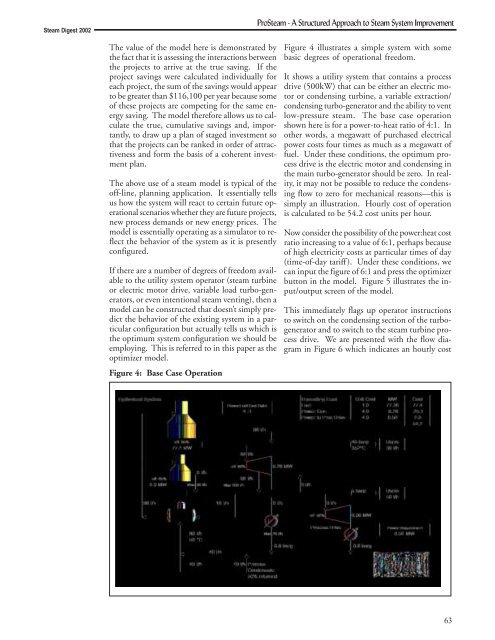Steam Digest 2002 - CiteSeerX
Steam Digest 2002 - CiteSeerX
Steam Digest 2002 - CiteSeerX
You also want an ePaper? Increase the reach of your titles
YUMPU automatically turns print PDFs into web optimized ePapers that Google loves.
<strong>Steam</strong> <strong>Digest</strong> <strong>2002</strong><br />
The value of the model here is demonstrated by<br />
the fact that it is assessing the interactions between<br />
the projects to arrive at the true saving. If the<br />
project savings were calculated individually for<br />
each project, the sum of the savings would appear<br />
to be greater than $116,100 per year because some<br />
of these projects are competing for the same energy<br />
saving. The model therefore allows us to calculate<br />
the true, cumulative savings and, importantly,<br />
to draw up a plan of staged investment so<br />
that the projects can be ranked in order of attractiveness<br />
and form the basis of a coherent investment<br />
plan.<br />
The above use of a steam model is typical of the<br />
off-line, planning application. It essentially tells<br />
us how the system will react to certain future operational<br />
scenarios whether they are future projects,<br />
new process demands or new energy prices. The<br />
model is essentially operating as a simulator to reflect<br />
the behavior of the system as it is presently<br />
configured.<br />
If there are a number of degrees of freedom available<br />
to the utility system operator (steam turbine<br />
or electric motor drive, variable load turbo-generators,<br />
or even intentional steam venting), then a<br />
model can be constructed that doesn’t simply predict<br />
the behavior of the existing system in a particular<br />
configuration but actually tells us which is<br />
the optimum system configuration we should be<br />
employing. This is referred to in this paper as the<br />
optimizer model.<br />
Figure 4: Base Case Operation<br />
Pro<strong>Steam</strong> - A Structured Approach to <strong>Steam</strong> System Improvement<br />
Figure 4 illustrates a simple system with some<br />
basic degrees of operational freedom.<br />
It shows a utility system that contains a process<br />
drive (500kW) that can be either an electric motor<br />
or condensing turbine, a variable extraction/<br />
condensing turbo-generator and the ability to vent<br />
low-pressure steam. The base case operation<br />
shown here is for a power-to-heat ratio of 4:1. In<br />
other words, a megawatt of purchased electrical<br />
power costs four times as much as a megawatt of<br />
fuel. Under these conditions, the optimum process<br />
drive is the electric motor and condensing in<br />
the main turbo-generator should be zero. In reality,<br />
it may not be possible to reduce the condensing<br />
flow to zero for mechanical reasons—this is<br />
simply an illustration. Hourly cost of operation<br />
is calculated to be 54.2 cost units per hour.<br />
Now consider the possibility of the power:heat cost<br />
ratio increasing to a value of 6:1, perhaps because<br />
of high electricity costs at particular times of day<br />
(time-of-day tariff). Under these conditions, we<br />
can input the figure of 6:1 and press the optimizer<br />
button in the model. Figure 5 illustrates the input/output<br />
screen of the model.<br />
This immediately flags up operator instructions<br />
to switch on the condensing section of the turbogenerator<br />
and to switch to the steam turbine process<br />
drive. We are presented with the flow diagram<br />
in Figure 6 which indicates an hourly cost<br />
63
















